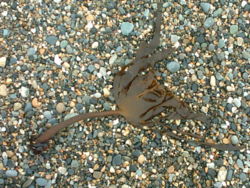Phaeophyceae
| Phaeophyceae |
|---|

|
| Scientific Classification |
|
| Orders |
Phaeophyceae can be found in marine environments. It is usually known as a brown algae (different from green algae and red algae) and usually lives in cooler or cold coastal waters (below 22°C or 72°F and down to 40m or 130 ft deep). Phaeophyceae is a large class formed by 265 genera and includes more than 1700 species [1]. It can range from threadlike seaweeds to the wide Giant Kelp which can grow up to 65m (200 ft.) tall and expand by 60cm (2 ft) per day. The class is useful because seaweed can be processed to produce Algin (emulsifier) that are used in 30 different commercial products such as vitamins, iodine, acetone, paints, toothpaste, shampoo, and many processed foods. [2]
Cell Structure
Phaeophyceae is usually photosynthetic, so it has to live in water shallow enough that it receives at least 1% of the sunlight the surface receives. The chloroplasts are typically discoid as in most plants, and the thylakoids, where photsysnthesis takes place, are in stacks of three to five, with girdle lamellae connecting the thylakoids. Phaeophyceae’s cell walls are composed of cellulose. The cellulose of the cell wall is usually stiffened by a mucilaginous material and calcium alginate forms the amorphous part of the wall so that the seaweed is flexible and moves with the water. A representative heterokont (a group that includes most algae) eyespot is present in most, however small numbers of species lack this eyespot. [3]
Reproduction
For example, the largest, fastest growing species in Phaeophyceae, macrocystis pyrifera, starts when spore producing sporophytes kind of the plant produce spores which germinate into either female or male gametophytes. These produce eggs or sperm so the gametophytes fertilize each other through ocean water. These form zygotes which will stick themselves to the ocean floor and grow into an adult plant. A kelp plant can release a trillion spores each year, however not many reach adulthood due to lack of sunlight, being eaten, or being buried by sediment.
Reproduction can happen in two ways with Phaeophyceae, it is either isogamous (where the gametes look alike), or anisogamous (with a large female egg, and small male sperm) depending on the species. Most common species are diplophaplontic, with an alternation of free-living generations. [4] [5]
Genome Structure
Phaeophyceae has two kinds of genomes, one is the mitochondria of L. digitata, which has 58000 base pairs and another genome is the mitochondria of P. littoralis, which has 38000 base pairs. The species Dictyota mentrualis have an affect on the HIV type 1. The antiretroviral activity was ascribed to 2 diterpenes, one is Da-1 and second is AcDa-1; these are usually from the algae. Two diterpenes usually taken together, and prove that both diterpenes inhibit HIV-1 RT and consequently virus replication. The species Myriotrichia clavaeformis have twelve chromosomes, however a few vary down to about four chromosomes by the species. [6]
Ecology
All but four species of Phaeophyceae live in salt water[7]. There are a few that live in the tropics but most live in temperate and polar waters. They bond themselves to hard surfaces such as rocks. A kelp forest provides a place for small marine animals to grow. A kelp forest usually consists of many kelp plants with thousand of species of animals and can run for miles and miles along the ocean. Sometimes the kelp plant's holdfast becomes detached and the kelp rises to the surface. This can form a floating mat which helps small fish in the middle of the ocean. However predators can also take advantage of the mats to find small fish. [8] Phaeophyceae’s geometric distribution is bimodal.
Rockweeds are plentiful on cold water shores, and the upper intertidal zone is a place where they form belts. Often, they form large stands in salt marshes in the Northern Hemisphere. Tropical waters sometimes support members of the family Sargassaceae and Dictyotales. Kelp forms in sub-tidal zones on most cold water shores and they also form a significant vegetation belt in the lower intertidal zone. [9]
Gallery
Giant Kelp (Macrocystis pyrifera)
Order: Laminariales
See Also
Related References
- Introduction of Phaeophyceae
- Phaeophyceae Microbewiki
- Phaeophyceae Answers
- Phaeophyceae Delwiche, Charles F. University of Maryland
- Class: Phaeophyceae Algaebase





